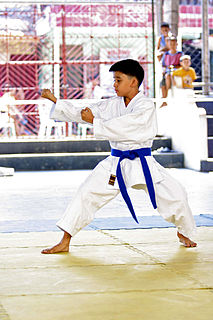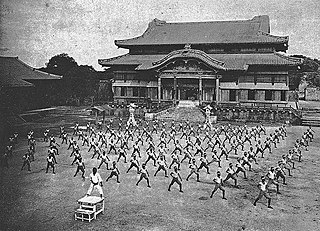Related Research Articles

Shotokan is a style of karate, developed from various martial arts by Gichin Funakoshi (1868–1957) and his son Gigo (Yoshitaka) Funakoshi (1906–1945). Gichin Funakoshi was born in Okinawa and is widely credited with popularizing "karate do" through a series of public demonstrations, and by promoting the development of university karate clubs, including those at Keio, Waseda, Hitotsubashi (Shodai), Takushoku, Chuo, Gakushuin, and Hosei.

Gōjū-ryū (剛柔流), Japanese for "hard-soft style", is one of the main traditional Okinawan styles of karate, featuring a combination of hard and soft techniques. Both principles, hard and soft, come from the famous martial arts book used by Okinawan masters during the 19th and 20th centuries, the Bubishi. Gō, which means hard, refers to closed hand techniques or straight linear attacks; jū, which means soft, refers to open hand techniques and circular movements. Gōjū-ryū incorporates both circular and linear movements into its curriculum, combining hard striking attacks such as kicks and close hand punches with softer open hand circular techniques for attacking, blocking, and controlling the opponent, including joint locks, grappling, takedowns, and throws.

Wadō-ryū (和道流) is one of the four major karate styles and was founded by Hironori Ōtsuka (1892–1982). The style itself places emphasis on not only striking, but tai sabaki, joint locks and throws. It has its origins within Tomari-te karate, but was also influenced by Shito-Ryu and Shotokan; and was also influenced by Ju-jitsu.

Shitō-ryū (糸東流) is a form of karate that was founded in 1934 by Kenwa Mabuni. Shitō-ryū is synthesis of the Okinawan Shuri-te and Naha-te schools of karate and today is considered one of the four main styles of the art.
Gojūshiho is a kata practiced in karate. Gojushiho was developed by Sokon Matsumura, one of the key founders of Okinawan martial arts and named it "Uesheishi", which literally means 54 methods in Chinese. In some styles of karate, there are two versions of this kata - Gojūshiho Shō and Gojūshiho Dai. An advantage of the two versions of the kata is to better master the difficult techniques presented therein, but not without facing some confusion, for many sequences are the same and others only slightly different. The embusen of both Gojūshiho Shō and Gojūshiho Dai are nearly identical. Gojūshiho Shō begins straight off with a wide variety of advanced techniques and, as such, is highly recommended for study. Gojūshiho Dai consists of many advanced open-handed techniques and attacks to the collar-bone.
Unsu (雲手), literally "cloud hands", is the most advanced kata found in the Shotokan and Shito-Ryu karate styles and is generally taught to karateka at the 3rd to 4th Dan. It contains many intricate hand techniques, such as the ippon-nukite in the opening sequence. Unsu also contains a 360-degree spinning double-kick with a double-leg take down at the same time, landing on the floor face-down before continuing. Because of this, it is a very common kata in tournaments and seen as method of testing the competitors knowledge, spirit and skill.
Sōchin (壯鎭) is a kata practiced in several styles of karate. It may have derived from Dragon style kung fu, and was taught in the Naha-te school in Okinawa by Seisho Arakaki. It was then passed down to Shitō-ryū. Later, a variation of it was introduced into the Shotokan style by Gichin Funakoshi's son, Yoshitaka. Some branches of Tang Soo Do have added it to their curriculum under the name "Sojin".
Wanshū is the name of several katas in many systems of karate, including Isshin-Ryu, Shotokan, Wadō-ryū, and others.

Kūshankū also called Kūsankū (クーサンクー) or Kankū-dai (観空大), is an open hand karate kata that is studied by many practitioners of Okinawan Karate, specifically styles related to Shuri-te. In many styles, such as Shotokan, there are two versions of the kata: Kūsankū-shō and Kūsankū-dai. The name Kūsankū or Kōsōkun (公相君) is used in Okinawan systems of karate, and refers to Kūsankū, a Chinese diplomat from Fukien who traveled to Okinawa in the 1700s. In Japanese systems of karate, the kata has been known as Kankū ever since it was renamed in the 1930s by Funakoshi Gichin. This kata is also practiced in Tang Soo Do as Kong Sang Koon in Korean according to the hangul rendering of the hanja 公相君. Most schools of Tang Soo Do only practice the "Dai" version but a handful do practice both the latter and "Sho" versions.
Passai, also Bassai (バッサイ), is the name of a group of kata practiced in different styles of martial arts, including karate and various Korean martial arts, including Taekwondo, Tang Soo Do, and Soo Bahk Do. There are several variations of these kata, including Passai sho (拔塞小) or minor Passai and Passai dai (拔塞大) or major Passai. The kata are generally known as Passai in Okinawan styles of karate and Bassai in Japanese styles, although Gichin Funakoshi originally spells the name of this form パッサイ (Passai). In Korean, the kata have several names: Bassahee, Bal Se, Pal Che, Palsek, Bal Sae, Ba Sa Hee, and Bal Sak. The kata focus on the idea of changing disadvantage into advantage by strong and courageous response, switching blocks and differing degrees of power. The feeling of kata should be precise, with fast execution of technique and attention given to appropriate balance between speed and power. Passai kata are usually classed as intermediate.
The karate kataSeisan (十三) literally means '13'. Some people refer to the kata as '13 Hands', '13 Fists', '13 Techniques', '13 Steps' or even '13 killing positions'; however, these names have no historical basis.

Chitō-ryū (千唐流) is a style of karate founded by Dr. Tsuyoshi Chitose, (1898-1984). The name of the style translates as: chi (千) - 1,000; tō (唐) - China; ryū (流) - style, school, "1,000 year old Chinese style." The character tō (唐) refers to the Tang Dynasty of China. The style was officially founded in 1946.
Naihanchi (ナイハンチ) is a karate Kata, performed in straddle stance. It translates to 'internal divided conflict'. The form makes use of in-fighting techniques and grappling. In Shorin-Ryu and Matsubayashi-ryū Naihanchi Shodan is the first Ni Kyu although it is taught to Yon Kyu occasionally before Evaluations for the Ni Kyu rank. It is also the first Shorin-ryu and Shindo jinen-ryu kata to start with a technique to the right instead of the left. There are three modern kata derived from this. Some researchers believe Nidan and Sandan were created by Anko Itosu, but others believe that it was originally one kata broken into three separate parts. The fact that only Naihanchi/Tekki Shodan has a formal opening suggests the kata was split.
The Taikyoku series is a series of kata in use in several types of karate. The name Taikyoku (太極) refers to the Chinese philosophical concept of Taiji. The Taikyoku kata were developed by Yoshitaka Funakoshi and introduced by Gichin Funakoshi as a way to simplify the principles of the already simplified Pinan/Heian series. The embusen, or pattern of the kata's movements, are the same as in Heian shodan. Students of karate systems that use the Taikyoku kata series are often introduced to them first, as a preparation for the Pinan/Heian kata. Gōjū Kai developed five of its own Taikyoku kata, based on the Shotokan katas and retaining the I-shaped embusen. The embusen (pathway) of all the Taikyoku kata is simple :
*--! | | | | !--#
Chintō (鎮東) is an advanced kata practiced in many styles of karate. According to legend, it is named after a stranded Chinese sailor, sometimes referred to as Annan, whose ship crashed on the Okinawan coast. To survive, Chintō kept stealing from the crops of the local people. Matsumura Sōkon, a Karate master and chief bodyguard to the Ryūkyūan king, was sent to defeat Chintō. In the ensuing fight, however, Matsumura found himself equally matched by the stranger, and consequently sought to learn his techniques.
Rōhai (鷺牌) meaning “image of a heron” or “sign of a heron” is a family of kata practiced in some styles of karate. The kata originated from the Tomari-te school of Okinawan martial arts. It was called Matsumora Rōhai, after Kosaku Matsumora, who was presumably its inventor. Ankō Itosu later took this kata and developed three kata from it: Rōhai shodan, Rōhai nidan, and Rōhai sandan. In Shorin-ryū and Matsubayashi-ryū this kata introduces Gedan Shotei Ate and Ippon Ashi Dachi. It contains a sequence of Tomoe Zuki exactly the same as the one in Bassai, although the ending of the sequence chains into Hangetsu Geri/Uke.
Shorin-ryu Seibukan, also known as Sukunaihayashi, is one of the many Okinawan Shorin-ryu styles of karate.

The Japan Karate Federation (JKF), a.k.a. Japan Karatedo Federation, is a national governing body of sport karate in Japan. The JKF is officially affiliated with the Japan Olympic Association (JOC), World Karate Federation (WKF), Japan Sports Association (JSA) and Japanese Budō Association (JBA). The styles recognized by the JKF are Wadō-ryū, Shotokan, Shito-ryu and Goju-ryu. The headquarters is located in Tokyo, Japan.

Okinawan martial arts refers to the martial arts, such as karate, tegumi and Okinawan kobudō, which originated among the indigenous people of Okinawa Island. Due to its central location, Okinawa was influenced by various cultures with a long history of trade and cultural exchange, including Japan, China and Southeast Asia, that greatly influenced the development of martial arts on Okinawa.
Japan Karatedo Federation Renbukai is a Bōgutsuki Karate organization.
References
- ↑ Karate: The Complete Kata; Kanazawa, H.
- ↑ Nakayama, Masatoshi. Best Karate vol 7. Kodansha International. ISBN 1568364660.
- ↑ Lee, Kang. "Tang Soo Do" A&C Black, 1998, p. 187
- ↑ "JMdictDB - Japanese Dictionary Database, 十手" . Retrieved 15 May 2016.